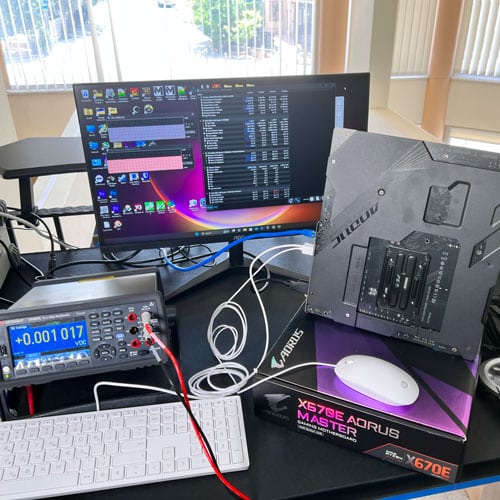After our article on SVI3, Gigabyte issues a statement confirming our findings.
I don’t want to change a single word in GBT’s statement, so you will find it below. Ok, I admit it, I fixed some typos!
May 18th, 2023
We would like to address the recent media reports regarding the SOC Voltage exceeding 1.3V on GIGABYTE’s AMD AM5 motherboards, especially when EXPO is enabled in the latest beta BIOS.
GIGABYTE respects and appreciates the media’s support and favor to GIGABYTE motherboards for a long time. Regarding the SOC Voltage measurement, the authentic measurement point and method are critical since the SOC Voltage will differ by that. The CPU internal SOC Voltage(SVI3 interface) is the most crucial indicator to motherboards. Generally, the PWM Output Voltage will be higher than the CPU internal SOC Voltage(SVI3 interface) due to various physical factors.
Users can use HWiNFO software to accurately monitor the CPU internal SOC Voltage(SVI3 interface), which is indicated as “CPU VDDCR_SOC Voltage (SVI3 TFN)” in HWiNFO. The internal sensor of the CPU reports this value to show the true voltage. GIGABYTE uses HWiNFO to monitor the SOC Voltage on AM5 motherboards, which is under 1.3V, which AMD officially confirms. The full lineup of GIGABYTE AM5 motherboards follows AMD’s latest SOC Voltage 1.3V Guideline when EXPO is enabled. Please refer to the following video for more details: https://youtu.be/HOUAy9n104A
GIGABYTE consistently works closely with AMD and follows AMD’s guidelines to comply with AMD’s official specifications and requirements fully. We appreciate all the attention and support from the media and customers. Our motivation has always been to deliver our customers more innovative and breakthrough products. As a leading motherboard manufacturer, we will continue to provide top-quality products for users to enjoy the best PC experience.
Conclusion
So from the statement provided above, we know two things, which I have also mentioned in my article.
- The SVI3 output is the one to take into account.
- There is no way to confirm SVI3 reported voltage values. In other words, what the CPU’s internal sensor reports.
- AMD confirmed that VSOC has to be below 1.3V at the CPU’s internal sensor and NOT at the mainboard’s VRM corresponding output.
For reference, the conclusion of my article on SVI3 was the following:
From all the above, I can safely assume that if you check your mainboard CPU VDDCR_SOC Voltage (SVI3 TFN) and find it below 1.30V while running a stressful benchmark and with EXPO enabled, you are safe, always according to AMD. For me, it is a problem that I cannot take physical measurements of this voltage, and I am troubled by the significant voltage drop of 0.05794V between the CPU socket and the circuit within the CPU.
Here is a list of affiliate links to get some good PSUs to use with Powenetics and/or your AMD system:



– Everyone is talking about ASUS and GIGABYTE… but nobody seems to try to test AsRock and MSI boards as well… I feel like everyone just assumes they are fine…
– Could you try checking them out as well?
– AsRock Taichi X670E is coming soon in my new pc build so I’d really like to be sure whether or not it’s 100% safe, especially if I enable EXPO…
So…I don’t get it…is it safe to buy an AM5 CPU now without going to the hassle of burning, warranty, etc? Or just stick with older AM4?
It is safe.